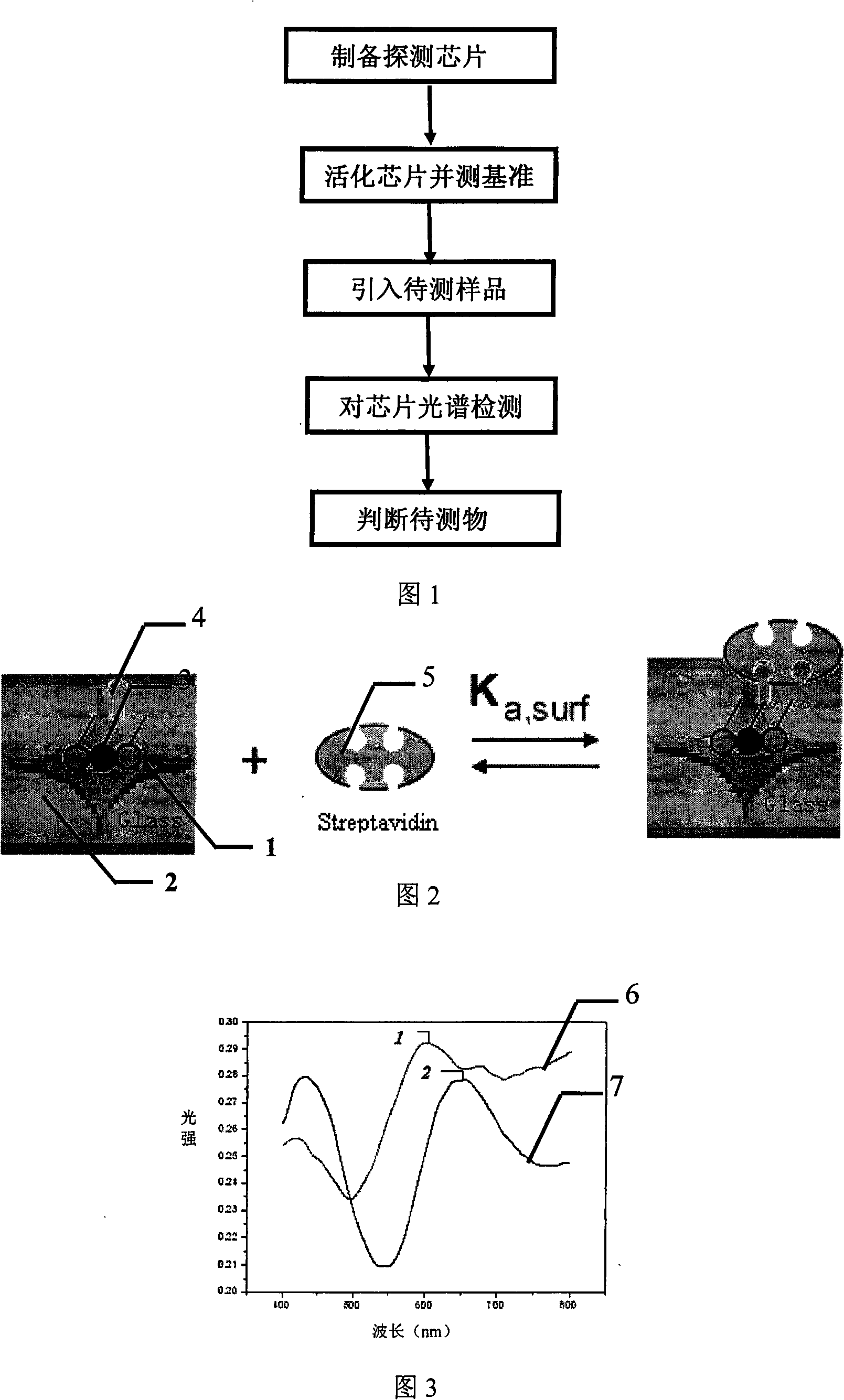Label-free biochemical detection method reinforced by utilizing local surface plasma
A plasma and localized surface technology, applied in the field of biochemical detection, can solve the problems of low sensitivity, high cost, long cycle, etc., and achieve the effect of high sensitivity, low cost and good bioaffinity
- Summary
- Abstract
- Description
- Claims
- Application Information
AI Technical Summary
Problems solved by technology
Method used
Image
Examples
Embodiment 1
[0030] Embodiment 1 In this embodiment, glass is used as the substrate, and the diamond-shaped metal silver structure arranged in a quadrilateral is used as the detection chip; the non-labeled biochemical detection method enhanced by local surface plasmon of the present invention is used to test bacteria, and the specific reaction process adopted is Bind antibodies on the chip.
[0031] First, glass is used as the substrate to select the chip substrate, cleaned and treated for hydrophilicity; on the surface of the substrate, a diamond-shaped nano-silver structure with an area of about 5 μm × 5 μm and a quadrilateral arrangement of 1 × 1 is produced by self-assembly of nanospheres. The characteristic size of the structure is 300nm; the nanostructure is metallized by silver plating to obtain a chip with the nanosilver structure on the surface of the substrate. Next, immobilize active groups on the surface of metal nanostructures (such as figure 2 shown in 3), and then throug...
Embodiment 2
[0033] In this embodiment, fused silica is used as the substrate, and the triangular metal gold structure arranged in hexagons is used as the detection chip; the local surface plasmon-enhanced unlabeled biochemical detection method of the present invention is used to test the toxin, and the specific reaction process adopted is Antigen binding on the chip.
[0034] First, fused silica is used as the substrate, cleaned and treated for hydrophilicity; on the surface of the substrate, a triangular nanostructure with a characteristic size of 50nm and hexagonal arrangement is produced by nanolithography; the nanostructure is metallized by gold plating to obtain A chip with a nano-gold structure on the surface of the substrate. Next, active groups are immobilized on the surface of the metal nanostructure, and then the antigen of the detected target bacterial molecule is immobilized on the active groups by a zero-distance coupling reagent. Through the above procedures, the chip activ...
Embodiment 3
[0036] In this embodiment, silicon is used as the substrate, and porous templates are produced by photolithography. The number of chip arrays is 150×150, and 150×150 protein antigens are integrated by the method of spotting, and the localized surface plasmon-enhanced Label-free biochemical detection methods test whether the analyte contains various types of proteins.
[0037]First, silicon is used as the substrate, cleaned and treated for hydrophilicity; nanostructure arrays with an array number of 150×150 are produced on the surface of the substrate by nanoimprinting, and the size of each subunit is 1000 μm×1000 μm; the nanostructure is metallized to obtain A chip with a nanometer metal structure on the surface of the substrate. The structure in each subunit can adopt different structures according to the different characteristics of the object to be tested. There are single-layer pentagrams, and there are upper and lower double-layer nano-silver structures composed of upper ...
PUM
| Property | Measurement | Unit |
|---|---|---|
| Size | aaaaa | aaaaa |
Abstract
Description
Claims
Application Information
 Login to View More
Login to View More - R&D
- Intellectual Property
- Life Sciences
- Materials
- Tech Scout
- Unparalleled Data Quality
- Higher Quality Content
- 60% Fewer Hallucinations
Browse by: Latest US Patents, China's latest patents, Technical Efficacy Thesaurus, Application Domain, Technology Topic, Popular Technical Reports.
© 2025 PatSnap. All rights reserved.Legal|Privacy policy|Modern Slavery Act Transparency Statement|Sitemap|About US| Contact US: help@patsnap.com

